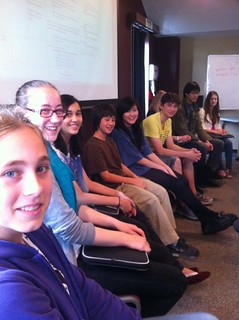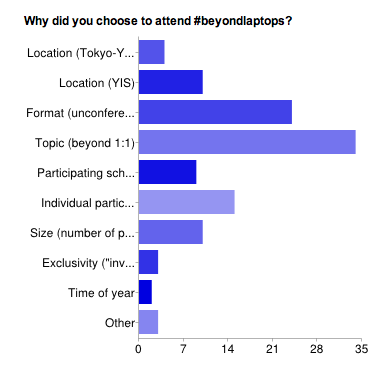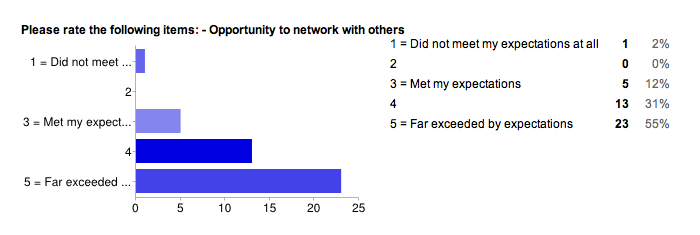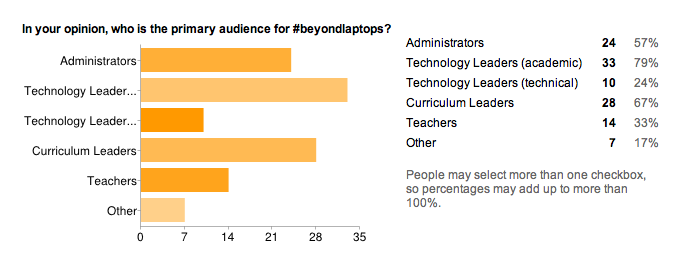Last week was a busy one at YIS. We had our first Digital Citizenship Week, with tons of great learning and reflection opportunities for our middle school students (more to come on this later), two meetings (Tues night & all day Saturday) of our YIS COETAIL cohort, and our #beyondlaptops mini-conference. Needless to say, by the time Sunday rolled around I was exhausted. And exhilarated.
I am so fortunate to be working at a school that encourages risk-taking, creativity, openness, collaboration and sharing. Not only is everything we do open and accessible, but we regularly welcome other schools to visit and see what we’re doing, in action. This is what #beyondlaptops is all about, and this is why we’re able to host this kind of event here at YIS.
Last year, while we were still planning our Connected Learning Community, our Headmaster, James MacDonald, had the brilliant idea of inviting school administrators, technology and curriculum leaders to YIS to brainstorm, together, based on our collective experience, how to successfully implement a 1:1 program. We had about 20 educators from around Asia join us for a day of informal discussion.
After what we consider a very successful first few months of our CLC, we thought it would be worthwhile to host the same event again, this time with the new focus of moving beyond discussions about hardware, infrastructure and visioning, including things like:
- Essential skills: what are they and how do we teach them?
- The future and beyond: envisioning a future we can not know
- Changes to learning environments and curriculum structure
- Staffing needs to support continual development
- Embracing Digital Citizenship as a community
- Embracing digital connectivity: when, how, why and where do we share?
- Evaluation and reflection: how do we know the program is “working”?
- Logistics and Management
- Student panel, sharing feedback from YIS and beyond
Building upon the year before, we wanted to keep it open and informal – no presentations, no “big name” speakers, no real structure, just ideas and facilitated discussion. We didn’t do much of a follow up last year since the group was so small, and it was more of an experiment than anything else, so we figured we could do something similar again this year.
Little did we know that we would end up with over 55 educators in the room.
Clearly, this is the type of event that people are looking for. A time to chat, to think, to share, to create together something more than we can do in our isolated, individual schools. An event, where the conference is the participants (thanks Simon for that gem of a tagline!).
As easy as (I hope) we made it look, this was not easy to pull together, and I learned quite a bit:
Go Informal!
Even though I regularly read blog posts where people complain about what they don’t get out of conferences, that the time most useful to them is the conversations in between formal sessions, I wasn’t entirely sure if all of the participants really understand how informal this event was going to be. We had a lot of “big name” schools attend, with quite a few administrators. Would they want to be told what to do? Or would they jump in with both feet?
I knew my tech coaching friends and colleagues would have no problem, but what about the people I didn’t know that well? The people that were being grouped together by one liaison at their school, so I never actually had any interaction with them at all before the conference started?
It turns out people not only felt well informed about the format (thanks Heather, for reassuring me), but that it was one of the key reasons they chose to attend:
Although I facilitated the discussions, and (ahem) perhaps over-planned the two days so we were constantly busy, people really jumped right into the conversations. They were open, they shared, the questioned, they left wanting more time to collaborate. In the feedback, almost every single person responded that the chance to have informal, but focused discussions, was a major highlight for them:
- The conference format allowed for engagement and relationship building with nearly all participants. not sitting and listening, but engaged in collaborative “work” and meaningful conversations.
- Discussions were rich with ideas and information…so much knowledge in the room.
- I loved having time to just talk about the issues, I got so many ideas that are easy to implement, I had just not thought of them. Being with other like professionals was amazing, there need to be more opportunities like this.
- Conversation, student participation, relaxed environment. Freedom to go down different avenues regarding different topics. Flexible schedule.
- I liked the sharing of this conference and that it was not a sit and get time. The conversations were meaningful and effective.
- Conversational style was great – allowed for diverse sharing of ideas, and exploration of approaches to shared concerns. I simply learnt a lot, and more importantly got to think of higher level things than nuts and bolts details of one to one.
The Conference is the Participants
OK, I’ll be honest. We didn’t charge anything for participants to attend, all they had to do was get themselves here and pay for their (very reasonably priced) hotel room. YIS covered all of the food for both days (amazing snacks and lunches at school thanks to Zest, our fabulous school caterers; and dinner on Thursday night at Green, our favorite local organic bar and grill).
So, I kinda thought that maybe, some people wouldn’t show up. That on Thursday morning I would wake up to a flurry of e-mails in my inbox saying that people got bogged down with work and had to cancel their plans. Aside from one minor aviation emergency (we missed you Rob!), and one health issue, every single person that signed up arrived, ready to start right on time.
Clearly, everyone in the room wanted to be in the room, and wanted to learn from the expertise in the room. We don’t need a “big name” speaker, although it was awesome to have Scott McLeod Skype in for an hour on Thursday (more on that later). As long as the conversations are facilitated, we can make the conference what we want, together.
Being “in the room” was a highlight for a number of participants:
- Unconference aspect; meeting old tech tribe and making new contacts
- Having the opportunity to meet people who I’ve been connected with online through Twitter
- Liked the small size of the conference which allowed for greater opportunity to develop relationships and connections
- Opportunity to discuss issues with well informed and passionate people
- I love that the focus was on discussion with people doing similar jobs as me. The most valuable take away from most conferences are the conversations with people. More and more, I am finding that more valuable than the workshops I attend. To have 2 whole days for discussion was the best PD I have had in a long time. Thank you.
Involve Students & Be Open
 I’m not entirely sure that every school could host an event like this. I am overly positive about YIS, but it’s for a good reason. Although we think we are doing many things well, we are not afraid to share our mistakes and to learn from them. I’ve worked at a number of schools that emphasize competition over community. I’m so proud that YIS is the opposite.
I’m not entirely sure that every school could host an event like this. I am overly positive about YIS, but it’s for a good reason. Although we think we are doing many things well, we are not afraid to share our mistakes and to learn from them. I’ve worked at a number of schools that emphasize competition over community. I’m so proud that YIS is the opposite.
So much of formal PD is about sharing what we do best, and highlighting our school’s strong points. Hardly any of it features actual students. We wanted to make sure that we listened to and respected our student voices, so we included them for both mornings:
- Thursday as part of our discussion of the essential skills for the future, Scott’s presentation and our debrief.
- On Friday, we had a student panel of ten 6 – 11th graders facing an audience of 55 school leaders and their only rule was to “be honest”. And they were. And we are so proud of them.
That’s not an easy thing to do, but it’s almost the norm here at YIS. We have students presenting and collaborating to and with visitors, teachers and admin on a regular basis – not the same students, either.
We have a community that values the input of it’s members, that respects everyone equally and supports open and honest dialogue. It’s a pretty good feeling.
It’s wonderful to see that our students were also a highlight for many participants (I’m not going to put the survey results here, because although they are very positive, I wouldn’t want any of the students to be upset by any of the work they did – they were amazing!)
- The inclusion of the students on both days were great! We need to keep the students directly involved in both these philosophical and decision-making processes.
- Including the students in the conference. Do it again!
- Hearing from students. Student voice is so important and not present enough in our P.D.
- Involving students was invaluable.
Teachers Like to Eat
I am one of them. Any event that feeds me well gets a gold star. In typical YIS fashion, we definitely earned our gold star. Zest, our amazing (and I do mean amazing) catering company provided healthy, delicious, organic snacks and lunches both days.
Plus, YIS sponsored Thursday night’s dinner at our favorite local organic restaurant, Green, with all-you-can drink craft beers (and anything else you might want). And then, I organized a “field trip” to Tokyo on Friday night (not sponsored by YIS) to Gonpachi which was equally wonderful. Considering the event was free, providing all of these amazing meals really was above and beyond. Thank you YIS!
Respect the Room
In our James’ opening to the conference he talked about the value and knowledge in the room, that we don’t have an easy answer to any of these questions, but we can find it together. There is so much value in acknowledging and respecting the experience and expertise we have together.
Likewise, it is so important to actually being in a room, physically together, seeing how people react, getting to know people on a personal level, and making deeper connections with the people you know already. As much as I love networking online, it’s clear to me that we need time to come together, in person, to delve deeper into the discussions we have online. We need this time to come together.
A few people came with a very focused agenda, and they were not all able to accomplish their goals, so we’re thinking of adding one more day to the conference as a totally unstructured pre-conference. A time when people who have a clear agenda (that may not be the agenda of the entire group of participants) can come together, undisturbed, to hash out the answers to their questions. (Thanks to Will Kirkwood for the idea!)
Organization is Key
So, turns out people love the unconference-style format. But that doesn’t mean that there was no organization involved. Just like facilitating learning in the classroom takes more organization than lecture-based lessons, so does an unconference. Just organizing the readings and resources was a handful!
A couple of items were especially challenging this time around:
Privacy: Because this event is “invite-only” (due to space limitations) most of the organization was done in Google Docs (I hate the feeling of excluding people, even if it’s not my choice). I kept one doc running with all the questions people were asking and kept referring everyone back to that one document. Now that the event has grown in size, the Google Docs method has really become unmanageable so most of this information is on the website, which will make things easier next year.
Local Information: Because we had such a small group last year, I really didn’t provide any information about Japan. I expected people would figure it out on their own and they did. This year, with such a large group, this really wasn’t possible. Thankfully, we had a very active Twitter hashtag with questions, so I could keep track and start posting the responses. Huge thanks to Brian Lockwood and Rob Newberry for their suggestions to many of the answers too!
Input: I really had no idea what people would want from this event. I was only confident about what the participants from YIS would want, so I wanted to make sure I included as many participants as I possibly could in all of the decision making. I created a separate Google Doc and invited 12 of the external participants (and all of our YIS participants) to share their input, to help guide the outcome:
- Susan Sedro
- Simon May
- Jabiz Raisdana
- Will Kirkwood
- Rob Newberry
- Colin Gallagher
- Stacey Stephens
- Dana Watts
- Thomas Galvez
- Adrienne Michetti
- John Turner
- Nick Sauers
Huge, huge, huge thanks to our YIS team of Stephen, Genki, Bob, James, John, Dennis, Elif, Rebekah, and Adam, plus Rob, Susan, Will, Thomas and John for all of your thoughtful feedback and participation in the planning. Without you, I would not have been able to pull it together, and would not have been able to come close to meeting the needs of the majority of the participants.
Next year, I’ll make sure to formalize this planning committee a little more so that different participants can take responsibility for different sections of the agenda. Not only will this be a great way to ensure variety, but it means that I can participate too! (Thanks to Tim Wojcik for the idea)
It’s All About the Team
Two of my biggest take-aways from #beyondlaptops unfortunately contradict each other:
- limit the number of participants (it will be capped at 30 people next year)
- ensure that everyone who participates comes with a team (minimum 2, maximum 4 people from each school)
We need to limit the participants both because of space, and because of the level of conversation we want to have. Although this was a very select group of people (I actually only sent out 3 e-mail invitations to a group of people that I know, and we ended up with 45 people from outside YIS), we still had some competing dialogue, some discussion that wasn’t quite what we were hoping for. Now, of course, it goes without saying that you can not stop people from having their own agenda or priorities, but it would be nice if we had a clearer vision of what those priorities were at the time of registration, so we could better select a group that would work very productively together.
So, limiting sounds like a great idea. Except that we know when people go off to a conference on their own, it’s so much harder to implement the ideas they learned about. So we also want to encourage teams to come. Specifically teams that include an administrator, a tech coach, a curriculum coordinator and a teacher – with no two people from the same job. In this way, we hope that not only will we get a more rounded perspective, but we can actually hope that some of the learnings will be implemented when they get back. This means that we’ll probably only have a maximum of 15 schools represented, instead of the 21 we had, but that’s OK. More focus, more productive sessions, and hopefully more action taken will be worth the slightly more limited exposure. (Thanks to Tim Bray for the idea!)
We Need to Be Pushed
Our only formal “speaker” was Scott McLeod, and he presented via Skype on Thursday. It was fantastic to see how Scott could actually facilitate a discussion and activity in Japan from the US via Skype (well, I may have helped a little). As usual, Scott’s presentation was controversial. He talked about the various companies that are working toward replacing teachers with computers (Knewton, Rocketship Education, New Classrooms, etc). Although the idea was not entirely new to me (thanks to Disrupting Class), I still enjoyed the feeling of being a little bit uncomfortable with the future Scott described.
Many of the participants are the change agents in their schools, they are the ones doing the pushing, they feel they are “ahead of the curve”. To have a conversation where we feel as confronted as some of our teachers do on a daily basis can only be a good thing. Thanks Scott!
Final Thoughts
Well, it’s seriously hard to believe that all I did was send out three e-mails (in January) to a group of educators I know personally, and we could all be sitting in Yokohama in April having a deep, thoughtful, respectful and open dialogue. I’m sorry that I didn’t get to participate in many of the discussions because I was facilitating, but I could feel the vibe in the room, and it was exciting. I love that so many of my colleagues around the world want to spend time talking together about these issues, and that they’re so passionate they will fly all the way to Japan to sit in a room together to hash things out.
Thank you so much to all of the participants for joining us. It really was our pleasure. We hope to see you again next year!


















Once again I am impressed with your work. It is so refreshing to see how open and willing you are share how things went at the Beyond Laptops conference. I feel that this is one of the main reasons why you had such demand from participants – you are one of the leaders in this shift and we want to see and talk about how things can be done.
We all had different journeys during the conference but I really think the process (from the set-up to this reflection) has helped to move our thinking along. May this experience be one of many as we move along the journey to changing the way students learn.
Thanks!
Thanks for such a comprehensive reflection. As usual, I am amazed by your efficiency and I am thinking that the next time I see you at a conference, I’ll have to suggest an unconference titled, “How to get a ton of stuff done” and I’ll put your name down as the facilitator.
It’s a giant responsibility to put together something like this. I only fear that you are giving more than you are getting. Can I suggest that next year you go ahead and be more explicitly selfish – tell people that you’ve gathered them together because you need help with XYZ. Let that need provide the structure. It will help guide us towards practical outcomes, and chances are it will be what others need as well.
Brady Cline´s last blog post ..#BeyondConferences – A Model for Multi-school Collaboration
Kim,
Once again, thanks for a great conference. And, once again, thanks for modeling best practice through using the data you collected at the conference to reflect on the conference. The discussions with students are very important in my mind, because they are the client and have a right to expect a certain level of quality in the service they receive from us. They can’t be the complete decision makers, but they do have a right to be at the table where the decisions are made. We don’t really see enough of that in education. Students can provide insights that we could never hope to learn on our own.
Cheers,
Tim
Congrats Kim…..looks like once again you’ve put on a fantastic learning experience for international educators and international schools.
Jeff Utecht´s last blog post ..Paying Attention to Attention
Kim, you have outdone yourself with this unconference. It was such a valuable experience for me, and for our Tech Director too, and we’ve already had several follow-up conversations about how to turn our take-aways int0 action.
It’s affirming to see that so many of the participants felt the same way I did in terms of what was best and what parts we felt most valuable. I definitely think that limiting participants is a plus — not only for the reasons you mentioned, but also because it gives us more of an opportunity to work with other people, and to truly branch out. I also love Will’s idea of the extra unstructured day — I had thought of this too, but not until I was on the plane back to Singapore.
The best part about all of it for me was that we weren’t talking about the tools. The kids weren’t either! We weren’t talking about the “small scale” (hate to use that term) pedagogy and technical bits that we often get so caught up over. Instead we were talking about big-picture ideas and ideals and how to achieve them. Being 1:1 presents many (often unexpected) challenges, and it is enriching to talk about those in an open sharing environment. Even knowing that one school’s context is not appropriate for another school’s solution — just chatting about it often brings up other solutions.
Thanks again for a memorable and highly practical PD experience.
What an amazingly thorough and transparent breakdown of #beyondlaptops. It makes me even more disappointed that I wasn’t able to attend this year. I have already made a mental note for next year though. Thanks again for sharing and being so open with the process as well as the product.
Now, about that instructional coaching summit we were discussing…. :)
Clint Hamada´s last blog post ..ASB Unplugged Reflection Part 2 – Unplanned, Unconference
Kim,
Thanks for taking the time to write such a thorough recap and congratulation on your successes and your vision for the future. I have already sent this post to my new principal in hopes that we might be able to send a team.